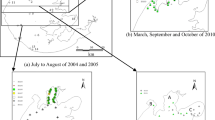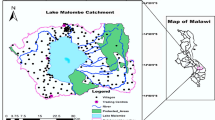Abstract
Chlorophyll-a (chl-a) is considered as a primary indicator for water quality and foods for oyster growth in Apalachicola estuarine ecosystem. Assessment of chl-a concentration variation in response to river inflow is important for estuarine environmental research and management. In this study, remote sensing analysis has been conducted to evaluate the effects of river inflow on chlorophyll concentrations in Apalachicola Bay of Florida in the northeast Gulf of Mexico. A remote sensing model for chl-a was improved and applied to map spatial distributions of chl-a by using Moderate Resolution Imaging Spectroradiometer (MODIS) 250-m resolution imageries in high-flow and low-flow seasons in 2001 and 2008. Chl-a values approximately ranged from the minimum 6 μg/l to the maximum 29 μg/l in the study period. Maximum chl-a concentration in high-flow season was almost twice above that in low-flow season. The averaged mean and minimum chl-a level in the high-flow season were approximately 42 and 28 % higher than those in low-flow season, respectively. The remote sensing mapping of chl-a was able to show spatial variations of chl-a in the entire bay under different flow conditions, which indicated its advantage over the traditional field data sampling for monitoring water quality over a large area of estuary. The MODIS 250-m remote sensing regression model presented from this study can be used to support monitoring and assessment of the spatial chl-a distribution in the bay for environmental research and management in Apalachicola Bay.






Similar content being viewed by others
References
ANERR. (2009). Apalachicola National Estuarine Research Reserve, Florida. Retrieved from http://www.eoearth.org/view/article/150141
CBP, (2009). Chesapeake Bay Program: chlorophyll-a: annual assessment web sites: http://www.chesapeakebay.net/status_chlorophyla.aspx?menuitem = 19649.
Chanton, J., & Lewis, F. G. (2002). Examination of coupling between primary and secondary production in a river-dominated estuary: Apalachicola Bay, Florida, U. S. A. Limnology and Oceanography, 47(3), 683–697.
Chen, S. S., Fang, L. G., Zhang, L. X., & Huang, W. R. (2009a). Remote sensing of turbidity in seawater intrusion reaches of pearl river estuary—a case study in Modaomen water way, China. Estuarine, Coastal and Shelf Science, 82(1), 119–127.
Chen, S. S., Huang, W. R., Wang, H. Q., & Li, D. (2009b). Remote sensing assessment of sediment re-suspension during hurricane Frances in Apalachicola Bay, USA. Remote Sensing of Environment, 113(12), 2670–2681.
Chen, J., Wen, Z., & Xiao, Z. (2011). Spectral geometric triangle properties of chlorophyll-a inversion in Taihu lake based on TM data. Journal of Water Resource and Protection, 2011(3), 67–75.
Dame, R. F., Wolaver, T. G., & Libes, S. M. (1985). The summer uptake and release of nitrogen by an intertidal oyster reef. Netherlands Journal of Sea Research, 19(3–4), 265–268.
Estabrook, R. H. (1973). Phytoplankton ecology and hydrography of Apalachicola Bay. In M. S. Thesis (Ed.), Department of Oceanography. Tallahassee, Florida: Florida State University.
FDEP-Florida Department of Environmental Protection (2012). Site-specific information in support of establishing numeric nutrient criteria in Apalachicola Bay. Report of Division of Environmental Assessment and Restoration, Standards and Assessment Section, 127 pages.
Han, L., & Jordan, K. J. (2005). Estimating and mapping chlorophyll-a concentration in Pensacola Bay, Florida using Landsat ETM + data. International Journal of Remote Sensing, 26, 5245–5254.
Huang, W., Jones, W. K,(1997). Three-dimensional modeling of circulation and salinity for the low river flow season in Apalachicola Bay, Florida. Northwest Florida Water Management District Water Resources Special Report 97–1, Havana, Florida.
Huang, W., Jones, W. K., & Wu, T. S. (2002). Modeling wind effects on subtidal salinity in Apalachicola Bay, Florida. Estuarine, Coastal and Shelf Science, 55(1), 33–46.
Lasker, R. (1975). Field criteria for survival of anchovy larvae—relation between Inshore chlorophyll maximum layers and successful 1st feeding. Fishery Bulletin, 73(3), 453–452.
Livingston, R. J. (1981). River-derived input of detritus into the Apalachicola Estuary. In R. D. Cross & D. L. Williams (Eds.), Proceedings of the national symposium on freshwater inflow to estuaries (pp. 320–332). Washington, DC: Fish and Wildlife Service.
Livingston RJ (1984) The ecology of the Apalachicola Bay system: an estuarine profile. U. S. Fish and Wildlife Service, Office of Biological Services. FWS/OBS-82/05. 148 p.
Livingston, R. J. (2001). Eutrophication processes in coastal systems. Boca Raton, Florida: CRC Press. 327p.
Livingston, R. J. (2003). Trophic organization in coastal systems. Boca Raton, Florida: CRC Press.
Livingston, R., Lewis, F. G., Woodsum, G. C., Niu, X. F., Galperin, B., Huang, W., Christensenf, J. D., Monacof, M. E., Battistaf, T. A., Klein, C. J., Howell, R. L., & Ray, G. L. (2000). Modeling oyster response to variation in freshwater input. Estuarine, Coastal and Shelf Science, 50(5), 655–672.
Loiselle, S., Bracchini, L., Bonechi, C., & Rossi, C. (2001). Modelling energy fluxes in remote wetland ecosystems with the help of remote sensing. Ecological Modelling, 145(2–3), 243–261.
Mainaa, J., Venus, V., McClanahana, M. R., & Ateweberhana, M. (2008). Modelling susceptibility of coral reefs to environmental stress using remote sensing data and GIS models. Ecological Modelling, 212(3–4), 180–199.
Miller, R. L., & McKee, B. A. (2004). Using MODIS Terra 250 m imagery to map concentrations of total suspended matter in coastal waters. Remote Sensing of Environment, 93(1–2), 259–266.
Monbet, Y. (1992). Control of phytoplankton biomass in estuaries—a comparative analyses of microtidal and macrotidal estuaries. Estuaries, 15(4), 563–571.
Mortazavi, B., Iverson, R. L., Landing, W. M., Lewis, F. G., & Huang, W. R. (2000). Control of phytoplankton production and biomass in a river-dominated estuary: Apalachicola Bay, FL, USA. Marine Ecology Progress, 198, 19–31.
Myers VB (1977) Nutrient limitation of phytoplankton productivity in north Florida coastal systems: technical considerations; spatial patterns; and wind mixing effects. Ph. D. Dissertation, Florida State University, FL.
Myers VB and Iverson RL (1977) Aspects of nutrient limitation of phytoplankton productivity in the Apalachicola Bay system. Pages 68–74 in R. J. Livingston and E. A. Joyce, Jr., eds. Proceedings of the Conference on the Apalachicola Drainage System. Fla. Dep. Nat. Resour. Mar. Res. Publ. 26.
Nixon, S. W., Arnrnerman, J. W., Atkinson, L. P., Berounsky, V. M., Billen, G., Boicourt, W. C., Boynton, W. R., Church, T. M., Ditoro, D. M., Elrngren, R., Garber, J. H., Giblin, A. E., Jahnke, R. A., Owens, N. J. P., Pilson, M. E. Q., & Seitzinger, S. P. (1996). The fate of nitrogen and phosphorus at the land-sea margin of the North Atlantic Ocean. Biogeochemistry, 35(1), 141–180.
Oki, K. (2010). Why is the ratio of reflectivity effective for chlorophyll estimation in the lake water? Remote Sensing, 2010(2), 1722–1730.
Pennock, J. R., Boyer, J. N., Herrera-Silveira, J. A., Iverson, R. L., Whitledge, T. E., Mortazavi, B., & Cornin, F. A. (1999). Nutrient behavior and phytoplankton production in Gulf of Mexico estuaries. In T. C. Bianchi, J. R. Pennock, & R. R. Twiliey (Eds.), Biogeochemistry of Gulf of Mexico estuaries (pp. 109–162). New York: Wiley.
Platt, T., White, G. N., Zhai, L., Sathyendranath, S., & Roy, S. (2009). The phenology of phytoplankton blooms: ecosystem indicators from remote sensing. Ecological Modelling, 220(21), 3057–3069.
Queensland Government Environment Protection Agency (1999). Water quality sampling manual, third edition, Brisbane, December 1999.
Rheault, R. B., & Rice, M. A. (1996). Food-limited growth and condition index in the eastern oyster, Crassostrea virginica (Gmelin 1791), and the bay scallop, Argopecten irradians irradians (Lamarck 1819). Journal of Shellfish Research, 15(2), 271–283.
Richardson, L. L., LeDrew, E. F. (Eds.) (2006). Remote sensing of aquatic coastal ecosystem processes. Science and management applications series: remote sensing and digital image processing, Vol. 9. XVII, Springer. ISBN-10 1-4020-3968-3 (ebook).
Soniat, T. M., Powell, E. N., Hofmann, E. E., & Klinck, J. M. (1998). Understanding the success and failure of oyster populations: the importance of sampled variables and sample timing. Journal of Shellfish Research, 17(4), 1149–1166.
Tebbs, E. J., Remedios, J. J., & Harper, D. M. (2013). Remote sensing of chlorophyll-a as a measure of cyanobacterial biomass in Lake Bogoria, a hypertrophic, saline–alkaline, flamingo lake, using Landsat ETM +. Remote Sensing of Environment, 135, 92–106.
Wang, H. Q., Hladik, C. M., Milla, K., Huang, W. R., Edmiston, L., Harwell, M. A., & Schalles, J. F. (2010). Detecting and mapping water quality indicators in Apalachicola Bay, Florida using MODIS Terra 250-m imagery. International Journal of Remote Sensing, 31(2), 439–453.
Whitfield, W. K., Jr., & Beaumariage, D. S. (1977). Shellfish management in Apalachicola Bay: past, present, and future. In proceedings of the conference on the Apalachicola drainage system. In R. J. Livingston & E. A. Joyce Jr. (Eds.), Florida department of natural department of natural resources marine research publications (26th ed., pp. 130–140).
Wolfe, R. E., Roy, D. P., & Vermote, E. (1998). MODIS land data storage, gridding, and compositing methodology: level 2 grid. IEEE Transactions on Geoscience and Remote Sensing, 36(4), 1324–1338.
Acknowledgments
The study was partially supported by the FAMU-FSU College of Engineering. The study was also partially supported by the National Natural Science Foundation of China (Grant Nos. 41201338 and 51279134), the Guangdong Science & Technology Plan Key Project (2011B031100003), and Guangdong Province Water Conservancy Science & Technology Innovation Project (2011–20).
Author information
Authors and Affiliations
Corresponding author
Rights and permissions
About this article
Cite this article
Huang, W., Chen, S., Yang, X. et al. Assessment of chlorophyll-a variations in high- and low-flow seasons in Apalachicola Bay by MODIS 250-m remote sensing. Environ Monit Assess 186, 8329–8342 (2014). https://doi.org/10.1007/s10661-014-4007-z
Received:
Accepted:
Published:
Issue Date:
DOI: https://doi.org/10.1007/s10661-014-4007-z




